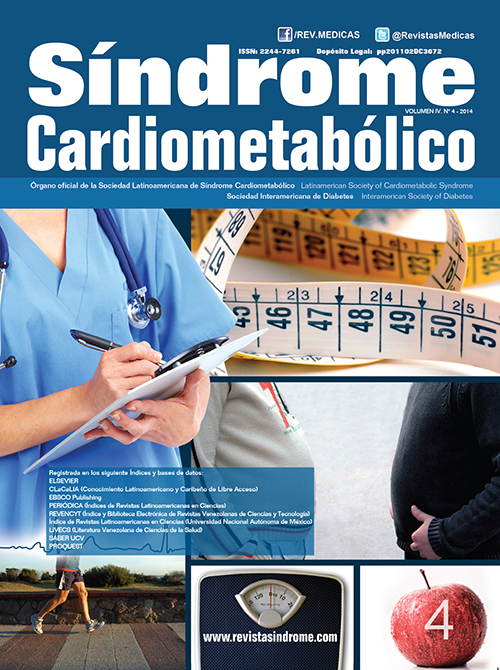Metabolic Syndrome components combinations: evidence of asymmetric clustering determined by central obesity and homeostasis model assessment
Palabras clave:
metabolic syndrome, metabolic risk components, HOMA, insulin resistanceResumen
Introduction: Metabolic syndrome (MS) is considereda cluster of metabolic risk factors which have been relatedwith insulin resistance (IR), yet its role in the pathologyof the syndrome remains unclear. The purpose of thisstudy is to evaluate the prevalence of MS, the clusteringof metabolic components, their relationship with IR andits degree of severity according to possible combinations.Materials and Methods: this is a cross-sectional study,with 2,230 individual from both sexes randomly selected,which were given a complete medical evaluation, includinganthropometric measurements, biochemical analysis andMS diagnosis was done using IDF/NHLBI/AHA-2009. Thequalitative variables were expressed as absolute and relativefrequencies, using c2 test for significance and Z teststo assess proportion´ differences. Logistic regression modelswere calculated for Odds ratio for IR and MS.Results: The overall prevalence of MS was 42.4%, with40.4% in women and 44.6% in men, respectively. Severalcombinations do not present IR and lack abdominalobesity, including Hypertension-Low HDL-Hypertriacilglyceridemia(n=4), Hypertension-Hyperglycemia-Low HDL(n=3), and Hypertension-Hyperglycemia-Low HDL-Hypertriacilglyceridemia(n=3). Elevated waist circumferenceis observed accompanying metabolic combinations thatpresent IR.Conclusions: This study reports an alarming prevalenceof MS in Maracaibo. When the possible combinationswere studied IR is not observed as a common feature.There are several combinations which cluster less, suggestingthat a variable such as WC could influence thevariability and frequency of the phenotypes and associatedIR, rendering central obesity as a mandatory featurein the diagnosis of MS.Key Words: metabolic syndrome, metabolic risk components,HOMA, insulin resistance.Descargas
Los datos de descargas todavía no están disponibles.
Descargas
Cómo citar
Bermúdez, V., Rojas, J., Añez, R., Salazar, J., Bello, L., Toledo, A., González, R., Apruzzese, V., Miquelena, E., David, A., Chávez, C., Chacín, M., Cano, C., Velasco, M., López-Miranda, J., & Cabrera, M. (2016). Metabolic Syndrome components combinations: evidence of asymmetric clustering determined by central obesity and homeostasis model assessment. Síndrome Cardiometabólico Y Enfermedades Crónico Degenerativas, 4(4). Recuperado a partir de http://saber.ucv.ve/ojs/index.php/rev_sc/article/view/9701
Número
Sección
Artículos

